A Systematic Review on Amaranthus-Related Research
Abstract
1. Introduction
2. Materials and Methods
2.1. Data Collection
2.2. Data Analysis
2.3. Data Visualization
2.4. Main Information
2.5. Annual Scientific Production
2.6. Most Relevant Authors
2.7. Most Relevant Institutions
2.8. Twenty Topmost Journals
2.9. Most Productive Countries
2.10. Data Visualization
Co-Authorship Authors
2.11. Co-Occurrence of Author Keywords
2.12. Author’s Co-Citation Analysis
3. Conclusions and Study Limitations
Author Contributions
Funding
Institutional Review Board Statement
Informed Consent Statement
Data Availability Statement
Conflicts of Interest
References
- Mavengahama, S.; McLachlan, M.; de Clercq, W. The role of wild vegetable species in household food security in maize based subsistence cropping systems. Food Secur. 2013, 5, 227–233. [Google Scholar] [CrossRef]
- Jimoh, M.O.; Afolayan, A.J.; Lewu, F.B. Suitability of Amaranthus species for alleviating human dietary deficiencies. S. Afr. J. Bot. 2018, 115, 65–73. [Google Scholar] [CrossRef]
- Salami, S.O.; Adegbaju, O.D.; Idris, O.A.; Jimoh, M.O.; Olatunji, T.L.; Omonona, S.; Orimoloye, I.R.; Adetunji, A.E.; Olusola, A.; Maboeta, M.S.; et al. South African wild fruits and vegetables under a changing climate: The implications on health and economy. S. Afr. J. Bot. 2021. [Google Scholar] [CrossRef]
- Akombi, B.J.; Agho, K.E.; Merom, D.; Renzaho, A.M.; Hall, J.J. Child malnutrition in sub-Saharan Africa: A meta-analysis of demographic and health surveys (2006–2016). PLoS ONE 2017, 12, e0177338. [Google Scholar] [CrossRef]
- Mark, H.E.; Dias Da Costa, G.; Pagliari, C.; Unger, S.A. Malnutrition: The silent pandemic. BMJ 2020, 371. [Google Scholar] [CrossRef]
- Webb, P.; Stordalen, G.A.; Singh, S.; Wijesinha-Bettoni, R.; Shetty, P.; Lartey, A. Hunger and malnutrition in the 21st century. BMJ 2018, 361, k2238. [Google Scholar] [CrossRef]
- Flyman, M.V.; Afolayan, A.J. The suitability of wild vegetables for alleviating human dietary deficiencies. S. Afr. J. Bot. 2006, 72, 492–497. [Google Scholar] [CrossRef]
- Grivetti, L.E.; Ogle, B.M. Value of traditional foods in meeting macro- and micronutrient needs: The wild plant connection. Nutr. Res. Rev. 2000, 13, 31–46. [Google Scholar] [CrossRef]
- Jimoh, M.O.; Afolayan, A.J.; Lewu, F.B. Toxicity and Antimicrobial Activities of Amaranthus caudatus L. (Amaranthaceae) Harvested from Formulated Soils at Different Growth Stages. J. Evid.-Based Integr. Med. 2020, 25, 1–11. [Google Scholar] [CrossRef]
- Subhasree, B.; Baskar, R.; Laxmi Keerthana, R.; Lijina Susan, R.; Rajasekaran, P. Evaluation of antioxidant potential in selected green leafy vegetables. Food Chem. 2009, 115, 1213–1220. [Google Scholar] [CrossRef]
- Sarker, U.; Oba, S. Response of nutrients, minerals, antioxidant leaf pigments, vitamins, polyphenol, flavonoid and antioxidant activity in selected vegetable amaranth under four soil water content. Food Chem. 2018, 252, 72–83. [Google Scholar] [CrossRef] [PubMed]
- Waselkov, K.E.; Boleda, A.S.; Olsen, K.M. A Phylogeny of the Genus Amaranthus (Amaranthaceae) Based on Several Low-Copy Nuclear Loci and Chloroplast Regions. Syst. Bot. 2018, 43, 439–458. [Google Scholar] [CrossRef]
- Venskutonis, P.R.; Kraujalis, P. Nutritional Components of Amaranth Seeds and Vegetables: A Review on Composition, Properties, and Uses. Compr. Rev. Food Sci. Food Saf. 2013, 12, 381–412. [Google Scholar] [CrossRef] [PubMed]
- Jimoh, M.O.; Afolayan, A.J.; Lewu, F.B. Nutrients and antinutrient constituents of Amaranthus caudatus L. Cultivated on different soils. Saudi J. Biol. Sci. 2020, 27, 3570–3580. [Google Scholar] [CrossRef]
- Rastogi, A.; Shukla, S. Amaranth: A New Millennium Crop of Nutraceutical Values. Crit. Rev. Food Sci. Nutr. 2013, 53, 109–125. [Google Scholar] [CrossRef]
- Jimoh, M.O.; Afolayan, A.J.; Lewu, F.B. Germination response of Amaranthus caudatus L. To soil types and environmental conditions. Thaiszia J. Bot. 2019, 29, 85–100. [Google Scholar] [CrossRef]
- Young, I.; Woodside, J. Antioxidants in health and disease. J. Clin. Pathol. 2001, 54, 176–186. [Google Scholar] [CrossRef]
- Repo-Carrasco-Valencia, R.; Hellström, J.K.; Pihlava, J.M.; Mattila, P.H. Flavonoids and other phenolic compounds in Andean indigenous grains: Quinoa (Chenopodium quinoa), kañiwa (Chenopodium pallidicaule) and kiwicha (Amaranthus caudatus). Food Chem. 2010, 120, 128–133. [Google Scholar] [CrossRef]
- Quiroga, A.V.; Barrio, D.A.; Añón, M.C. Amaranth lectin presents potential antitumor properties. LWT-Food Sci. Technol. 2015, 60, 478–485. [Google Scholar] [CrossRef]
- Jiménez-Aguilar, D.M.; Grusak, M.A. Minerals, vitamin C, phenolics, flavonoids and antioxidant activity of Amaranthus leafy vegetables. J. Food Compos. Anal. 2017, 58, 33–39. [Google Scholar] [CrossRef]
- Jimoh, M.O.; Afolayan, A.J.; Lewu, F.B. Therapeutic uses of Amaranthus caudatus L. Trop. Biomed. 2019, 36, 1038–1053. [Google Scholar] [PubMed]
- Jimoh, M.O.; Afolayan, A.J.; Lewu, F.B. Antioxidant and phytochemical activities of Amaranthus caudatus L. harvested from different soils at various growth stages. Sci. Rep. 2019, 9, 12965. [Google Scholar] [CrossRef] [PubMed]
- Assad, R.; Reshi, Z.A.; Jan, S.; Rashid, I. Biology of Amaranths. Bot. Rev. 2017, 83, 382–436. [Google Scholar] [CrossRef]
- Soriano-García, M.; Ilnamiqui Arias-Olguín, I.; Pablo Carrillo Montes, J.; Genaro Rosas Ramírez, D.; Silvestre Mendoza Figueroa, J.; Flores-Valverde, E.; Rita Valladares-Rodríguez, M. Nutritional functional value and therapeutic utilization of Amaranth. J. Anal. Pharm. Res. 2018, 7, 596–600. [Google Scholar] [CrossRef]
- Jo, H.J.; Chung, K.H.; Yoon, J.A.; Lee, K.J.; Song, B.C.; An, J.H. Radical scavenging activities of tannin extracted from amaranth (Amaranthus caudatus L.). J. Microbiol. Biotechnol. 2015, 25, 795–802. [Google Scholar] [CrossRef] [PubMed]
- Akin-Idowu, P.E.; Odunola, O.A.; Gbadegesin, M.A.; Ademoyegun, O.T.; Aduloju, A.O.; Olagunju, Y.O. Nutritional evaluation of Five Species of Grain Amaranth—An Underutilized Crop. Int. J. Sci. 2017, 3, 18–27. [Google Scholar] [CrossRef][Green Version]
- Mekonnen, G.; Woldesenbet, M.; Teshale, T.; Biru, T. Amaranthus Caudatus Production and Nutrition Contents for Food Security and Healthy Living in Menit Shasha, Menit Goldya and Maji Districts of Bench Maji Zone, South Western Ethiopia. Nutr. Food Sci. Int. J. 2018, 7, 001–007. [Google Scholar] [CrossRef]
- Písaříková, B.; Kráčmar, S.; Herzig, I. Amino acid contents and biological value of protein Amaranth. Czech J. Anim. Sci. 2005, 50, 169–174. [Google Scholar] [CrossRef]
- Mlakar, S.G.; Turinek, M.; Jakop, M.; Bavec, M.; Bavec, F. Nutrition value and use of grain amaranth: Potential future application in bread making. Agricultura 2009, 6, 43–53. [Google Scholar]
- Dichi, I.; Breganó, J.W.; Simão, A.N.C.; Cecchini, R. Role of Oxidative Stress in Chronic Diseases; Dichi, I., Breganó, J.W., Simão, A.N.C., Cecchini, R., Eds.; CRC Press: Boca Raton, FL, USA, 2014. [Google Scholar]
- Unuofin, J.O.; Lebelo, S.L. Antioxidant Effects and Mechanisms of Medicinal Plants and Their Bioactive Compounds for the Prevention and Treatment of Type 2 Diabetes: An Updated Review. Oxid. Med. Cell. Longev. 2020, 2020, 1356893. [Google Scholar] [CrossRef]
- Tonisi, S.; Okaiyeto, K.; Mabinya, L.V.; Okoh, A.I. Evaluation of bioactive compounds, free radical scavenging and anticancer activities of bulb extracts of Boophone disticha from Eastern Cape Province, South Africa. Saudi J. Biol. Sci. 2020, 27, 3559–3569. [Google Scholar] [CrossRef]
- Anand, U.; Jacobo-Herrera, N.; Altemimi, A.; Lakhssassi, N. A comprehensive review on medicinal plants as antimicrobial therapeutics: Potential avenues of biocompatible drug discovery. Metabolites 2019, 9, 258. [Google Scholar] [CrossRef] [PubMed]
- Martirosyan, D.M.; Miroshnichenko, L.A.; Zoloedov, V.I.; Pogojeva, A.V.; Kulakova, S.N. Amaranth oil application for coronary heart diseases. Lipids Health Dis. 2007, 6, 44–45. [Google Scholar] [CrossRef] [PubMed][Green Version]
- Lehmann, J. A handful of carbon. Nature 2007, 447, 143–144. [Google Scholar] [CrossRef] [PubMed]
- Lin, B.F.; Chiang, B.L.; Lin, J.Y. Amaranthus spinosus water extract directly stimulates proliferation of B lymphocytes in vitro. Int. Immunopharmacol. 2005, 5, 711–722. [Google Scholar] [CrossRef] [PubMed]
- Hussain, Z.; Amresh, G.; Singh, S.; Rao, C.V. Antidiarrheal and antiulcer activity of Amaranthus spinosus in experimental animals. Pharm. Biol. 2009, 47, 932–939. [Google Scholar] [CrossRef]
- Lipkin, A.; Anisimova, V.; Nikonorova, A.; Babakov, A.; Krause, E.; Bienert, M.; Grishin, E.; Egorov, T. An antimicrobial peptide Ar-AMP from amaranth (Amaranthus retroflexus L.) seeds. Phytochemistry 2005, 66, 2426–2431. [Google Scholar] [CrossRef]
- Bello, Z.A.; Walker, S. Evaluating AquaCrop model for simulating production of amaranthus (Amaranthus cruentus) a leafy vegetable, under irrigation and rainfed conditions. Agric. For. Meteorol. 2017, 247, 300–310. [Google Scholar] [CrossRef]
- Alegbejo, J. Nutritional Value and Utilization of Amaranthus (Amaranthus spp.)—A Review. Bayero J. Pure Appl. Sci. 2014, 6, 136. [Google Scholar] [CrossRef]
- Adewale, A.; Olorunju, A.E. Modulatory of effect of fresh Amaranthus caudatus and Amaranthus hybridus aqueous leaf extracts on detoxify enzymes and micronuclei formation after exposure to sodium arsenite. Pharmacogn. Res. 2013, 5, 305. [Google Scholar] [CrossRef] [PubMed]
- Sarker, U.; Oba, S. Nutritional and bioactive constituents and scavenging capacity of radicals in Amaranthus hypochondriacus. Sci. Rep. 2020, 10, 19962. [Google Scholar] [CrossRef] [PubMed]
- Sedibe, M.M.; Combrink, N.J.J.; Reinten, E.Y. Leaf yield of Amaranthus hypochondriatus L. (Imbuya), affected by irrigation systems and water quality. S. Afr. J. Plant Soil 2013, 22, 171–174. [Google Scholar] [CrossRef][Green Version]
- Szabóová, M.; Záhorský, M.; Gažo, J.; Geuens, J.; Vermoesen, A.; Hondt, E.D.; Hricov, A. Commercial Amaranth Varieties (Amaranthus spp.). Plants 2020, 9, 1–15. [Google Scholar]
- Adetutu, A.; Olorunnisola, O.S.; Owoade, A.O.; Adegbola, P. Inhibition of in vivo growth of plasmodium berghei by launaea taraxacifolia and amaranthus viridis in mice. Malar. Res. Treat. 2016, 2016, 9248024. [Google Scholar] [CrossRef] [PubMed]
- Salvamani, S.; Gunasekaran, B.; Shukor, M.Y.; Shaharuddin, N.A.; Sabullah, M.K.; Ahmad, S.A. Anti-HMG-CoA reductase, antioxidant, and anti-inflammatory activities of amaranthus viridis leaf extract as a potential treatment for hypercholesterolemia. Evid.-Based Complement. Altern. Med. 2016, 2016, 8090841. [Google Scholar] [CrossRef]
- Mncwango, N.; Mavengahama, S.; Ntuli, N.; Van Jaarsveld, C. Diversity, consumption dynamics and ethnomedical claims of traditional leafy vegetables consumed by a rural community in the KwaMbonambi area, northern KwaZulu-Natal, South Africa. Biodivers. J. Biol. Divers. 2020, 21, 1201–1207. [Google Scholar] [CrossRef]
- Okoye, N.F.; Monago-Ighorodge, C.C.; Akpobasaha, N.A. Evaluating the use of spiny pigweed (Amaranthus spinosus) and water leaf (Talinum triangulare) for bioremediation of crude oil polluted soil in Ikarama Community in Bayelsa State Nigeria. J. Appl. Sci. Environ. Manag. 2017, 21, 903. [Google Scholar] [CrossRef]
- Girija, K.; Lakshman, K.; Udaya, C.; Sabhya Sachi, G.; Divya, T. Anti–diabetic and anti–cholesterolemic activity of methanol extracts of three species of Amaranthus. Asian Pac. J. Trop. Biomed. 2011, 1, 133–138. [Google Scholar] [CrossRef]
- Sukhorukov, A.P.; Martín-Bravo, S.; Verloove, F.; Maroyi, A.; Iamonico, D.; Catarino, L.; El Mokni, R.; Daniel, T.F.; Belyaeva, I.V.; Kushunina, M. Chorological and taxonomic notes on African plants. Bot. Lett. 2016, 163, 417–428. [Google Scholar] [CrossRef]
- Schabort, C.J.; Faul, C.; Nagel, M.; Marx, S. Fermentation of lignocellulosic biomass using ultrasonic pretreatment. In Proceedings of the 22nd European Biomass Conference and Exhibition, Hamburg, Germany, 23–26 June 2014. [Google Scholar] [CrossRef]
- House, N.C.; Puthenparampil, D.; Malayil, D.; Narayanankutty, A. Variation in the polyphenol composition, antioxidant, and anticancer activity among different Amaranthus species. S. Afr. J. Bot. 2020, 135, 408–412. [Google Scholar] [CrossRef]
- Achigan-Dako, E.G.; Sogbohossou, O.E.D.; Maundu, P. Current knowledge on Amaranthus spp.: Research avenues for improved nutritional value and yield in leafy amaranths in sub-Saharan Africa. Euphytica 2014, 197, 303–317. [Google Scholar] [CrossRef]
- Mellem, J.J.; Baijnath, H.; Odhav, B. Translocation and accumulation of Cr, Hg, As, Pb, Cu and Ni by Amaranthus dubius (Amaranthaceae) from contaminated sites. J. Environ. Sci. Health—Part A Toxic/Hazard. Subst. Environ. Eng. 2009, 44, 568–575. [Google Scholar] [CrossRef]
- Omamt, E.N.; Hammes, P.S.; Robbertse, P.J. Differences in salinity tolerance for growth and water-use efficiency in some amaranth (Amaranthus spp.) genotypes. N. Z. J. Crop Hortic. Sci. 2006, 34, 11–22. [Google Scholar] [CrossRef]
- Medoua, G.N.; Oldewage-Theron, W.H. Effect of drying and cooking on nutritional value and antioxidant capacity of morogo (Amaranthus hybridus) a traditional leafy vegetable grown in South Africa. J. Food Sci. Technol. 2014, 51, 736–742. [Google Scholar] [CrossRef]
- Iamonico, D.; El Mokni, R. Amaranthus tunetanus (Amaranthaceae), a new species from Tunisia and a diagnostic key to the North African taxa in subgen. Albersia. S. Afr. J. Bot. 2018, 114, 78–83. [Google Scholar] [CrossRef]
- Pilon-Smits, E. Phytoremediation. Annu. Rev. Plant Biol. 2005, 56, 15–39. [Google Scholar] [CrossRef] [PubMed]
- Cunningham, S.D.; Ow, D.W. Promises and prospects of phytoremediation. Plant Physiol. 1996, 110, 715–719. [Google Scholar] [CrossRef]
- Jimoh, M.O.; Afolayan, A.J.; Lewu, F.B. Heavy metal uptake and growth characteristics of Amaranthus caudatus L. under five different soils in a controlled environment. Not. Bot. Horti Agrobot. 2020, 48, 417–425. [Google Scholar] [CrossRef]
- Jimoh, M.A.; Jimoh, M.O. Economic Consequences of Plant Biodiversity Loss. In Plants and the Ecosystems; Aliero, A.A., Agboola, D.A., Vwioko, E.D., Eds.; FUK Press, Federal University of Kashere: Kashere, Nigeria, 2021; pp. 397–411. ISBN 9789789889891. [Google Scholar]
- Cobbett, C.; Goldsbrough, P. Phytochelatins and metallothioneins: Roles in heavy metal detoxification and homeostasis. Annu. Rev. Plant Biol. 2002, 53, 159–182. [Google Scholar] [CrossRef]
- Krämer, U. Metal hyperaccumulation in plants. Annu. Rev. Plant Biol. 2010, 61, 517–534. [Google Scholar] [CrossRef]
- Clemens, S.; Ma, J.F. Toxic Heavy Metal and Metalloid Accumulation in Crop Plants and Foods. Annu. Rev. Plant Biol. 2016, 67, 489–512. [Google Scholar] [CrossRef] [PubMed]
- Ray, R.; Jana, T.K. Carbon sequestration by mangrove forest: One approach for managing carbon dioxide emission from coal-based power plant. Atmos. Environ. 2017, 171, 149–154. [Google Scholar] [CrossRef]
- Yang, P.; Gan, T.; Pi, W.; Cao, M.; Chen, D.; Luo, J. Effect of using Celosia argentea grown from seeds treated with a magnetic field to conduct Cd phytoremediation in drought stress conditions. Chemosphere 2021, 280, 130724. [Google Scholar] [CrossRef] [PubMed]
- Okunlola, G.O.; Jimoh, M.A.; Olatunji, O.A.; Olowolaju, E.D. Comparative study of the phytochemical contents of Cochorus olitorius and Amaranthus hybridus at different stages of growth comparative study of the phytochemical contents. Ann. West Univ. Timis. Ser. Biol. 2017, 20, 43–48. [Google Scholar]
- Rehaman, S.; El-Sheikh, M.A.; Alfarhan, A.H.; Ushani, U. Spectral studies of Amaranthus tristis Linn. in Bioremediated Silk dyeing effluent with mixed biofertilizer inoculants. Saudi J. Biol. Sci. 2021, 28, 1203–1212. [Google Scholar] [CrossRef]
- Trucco, F.; Tranel, P.J. Amaranthus. In Wild Crop Relatives: Genomic and Breeding Resources; Kole, C., Ed.; Springer: Berlin/Heidelberg, Germany, 2011; pp. 11–21. ISBN 9783642204500. [Google Scholar] [CrossRef]
- Okaiyeto, K.; Oguntibeju, O.O. Trends in diabetes research outputs in South Africa over 30 years from 2010 to 2019: A bibliometric analysis. Saudi J. Biol. Sci. 2021, 28, 2914–2924. [Google Scholar] [CrossRef]
- Linnenluecke, M.K.; Marrone, M.; Singh, A.K. Conducting systematic literature reviews and bibliometric analyses. Aust. J. Manag. 2020, 45, 175–194. [Google Scholar] [CrossRef]
- Okaiyeto, K.; Oguntibeju, O. Evaluation of 100 most cited research articles on African medicinal plants. Plant Sci. Today 2021, 8, 340–351. [Google Scholar] [CrossRef]
- Orimoloye, I.R.; Ololade, O.O. Global trends assessment of environmental health degradation studies from 1990 to 2018. Environ. Dev. Sustain. 2021, 23, 3251–3264. [Google Scholar] [CrossRef]
- Rodrigues, S.P.; van Eck, N.J.; Waltman, L.; Jansen, F.W. Mapping patient safety: A large-scale literature review using bibliometric visualisation techniques. BMJ Open 2014, 4, e004468. [Google Scholar] [CrossRef]
- Wrigley, J.; Carden, V.; von Isenburg, M. Bibliometric mapping for current and potential collaboration detection. J. Med. Libr. Assoc. 2019, 107, 597. [Google Scholar] [CrossRef] [PubMed]
- Jan van Eck, N.; Waltman, L. Software survey: VOSviewer, a computer program for bibliometric mapping. Scientometrics 2010, 84, 523–538. [Google Scholar] [CrossRef] [PubMed]
- Faber, R.J.; Laubscher, C.P.; Jimoh, M.O. The Importance of Sceletium tortuosum (L.) N.E. Brown and Its Viability as a Traditional African Medicinal Plant. In Pharmacognosy—Medicinal Plants; IntechOpen: London, UK, 2021; pp. 1–12. ISBN 978-1-83969-276-5. [Google Scholar]
- Smith, C. Natural antioxidants in prevention of accelerated ageing: A departure from conventional paradigms required. J. Physiol. Biochem. 2018, 74, 549–558. [Google Scholar] [CrossRef]
- Shen, B. A New Golden Age of Natural Products Drug Discovery. Cell 2015, 163, 1297–1300. [Google Scholar] [CrossRef] [PubMed]
- Peter, K.; Gandhi, P. Rediscovering the therapeutic potential of Amaranthus species: A review. Egypt. J. Basic Appl. Sci. 2017, 4, 196–205. [Google Scholar] [CrossRef]
- Kumar, B.S.A.; Lakshman, K.; Jayaveera, K.N.; Velmurugan, C.; Manoj, B.; Sridhar, S.M. Anthelmintic activity of methanol extract of Amaranthus caudatus Linn. Internet J. Food Saf. 2010, 12, 127–129. [Google Scholar]
- Hirsch, J.E. An index to quantify an individual’s scientific research output. Proc. Natl. Acad. Sci. USA 2005, 102, 16569–16572. [Google Scholar] [CrossRef]
- Onofrio, R. A proposal for a quantitative indicator of original research output. EPL 2017, 120, 50001. [Google Scholar] [CrossRef][Green Version]
- Sreelathakumary, I.; Peter, K.V. Amaranth: Amaranthus spp. In Genetic Improvement of Vegetable Crops; Elsevier: Amsterdam, The Netherlands, 1993; pp. 315–323. [Google Scholar]
- Sauer, J.D. The Grain Amaranths and Their Relatives: A Revised Taxonomic and Geographic Survey. Ann. Mo. Bot. Gard. 1967, 54, 103. [Google Scholar] [CrossRef]
- Buckley, Y.M.; Catford, J. Does the biogeographic origin of species matter? Ecological effects of native and non-native species and the use of origin to guide management. J. Ecol. 2016, 104, 4–17. [Google Scholar] [CrossRef]
- Jimoh, M.O.; Afolayan, A.J.; Lewu, F.B. Micromorphological assessment of leaves of Amaranthus caudatus L. cultivated on formulated soil types. Appl. Ecol. Environ. Res. 2019, 17, 13593–13605. [Google Scholar] [CrossRef]
- Alvarez-Jubete, L.; Arendt, E.K.; Gallagher, E. Nutritive value of pseudocereals and their increasing use as functional gluten-free ingredients. Trends Food Sci. Technol. 2010, 21, 106–113. [Google Scholar] [CrossRef]
- Lin, J.Y.; Li, C.Y.; Lin, B.F. Amaranthus spinosus L. inhibits spontaneous and dexamethasone-induced apoptosis in murine primary splenocytes. J. Food Drug Anal. 2008, 16, 52–61. [Google Scholar] [CrossRef]
- Adegbaju, O.D.; Otunola, G.A.; Afolayan, A.J. Proximate, mineral, vitamin and anti-nutrient content of Celosia argentea at three stages of maturity. S. Afr. J. Bot. 2019, 124, 372–379. [Google Scholar] [CrossRef]
- Dickersin, K.; Min, Y.I.; Meinert, C.L. Factors Influencing Publication of Research Results: Follow-up of Applications Submitted to Two Institutional Review Boards. JAMA J. Am. Med. Assoc. 1992, 267, 2891–2892. [Google Scholar] [CrossRef]
- Cummings, J.N.; Kiesler, S. Collaborative research across disciplinary and organizational boundaries. Soc. Stud. Sci. 2005, 35, 703–722. [Google Scholar] [CrossRef]
- Muriithi, P.; Horner, D.; Pemberton, L.; Wao, H. Factors influencing research collaborations in Kenyan universities. Res. Policy 2018, 47, 88–97. [Google Scholar] [CrossRef]
- Guo, Y.; Huang, Z.; Guo, J.; Li, H.; Guo, X.; Nkeli, M. Bibliometric analysis on smart cities research. Sustainability 2019, 11, 3606. [Google Scholar] [CrossRef]
- Deng, Z.; Wang, H.; Chen, Z.; Wang, T. Bibliometric Analysis of Dendritic Epidermal T Cell (DETC) Research From 1983 to 2019. Front. Immunol. 2020, 11, 259. [Google Scholar] [CrossRef]
- Uwizeye, D.; Karimi, F.; Otukpa, E.; Ngware, M.W.; Wao, H.; Igumbor, J.O.; Fonn, S. Increasing collaborative research output between early-career health researchers in Africa: Lessons from the CARTA fellowship program. Glob. Health Action 2020, 13, 1768795. [Google Scholar] [CrossRef]
- Frantz, J.M.; Leach, L.; Pharaoh, H.; Bassett, S.H.; Roman, N.V.; Smith, M.R.; Travill, A. Research capacity development in a South African higher education institution through a north-south collaboration. S. Afr. J. High. Educ. 2014, 28, 1216–1229. [Google Scholar] [CrossRef]
- Uddin, S.; Hossain, L.; Rasmussen, K. Network Effects on Scientific Collaborations. PLoS ONE 2013, 8, e57546. [Google Scholar] [CrossRef] [PubMed]
- Maleka, E.N.; Currie, P.; Schneider, H. Research collaboration on community health worker programmes in low-income countries: An analysis of authorship teams and networks. Glob. Health Action 1606, 12, 1606570. [Google Scholar] [CrossRef] [PubMed]
- Xiang, C.; Wang, Y.; Liu, H. A scientometrics review on nonpoint source pollution research. Ecol. Eng. 2017, 99, 400–408. [Google Scholar] [CrossRef]
- Lulewicz-Sas, A. Corporate social responsibility in the light of management science–bibliometric analysis. Procedia Eng. 2017, 182, 412–417. [Google Scholar] [CrossRef]
- Mao, X.; Chen, C.; Wang, B.; Hou, J.; Xiang, C. A global bibliometric and visualized analysis in the status and trends of subchondral bone research. Medicine 2020, 99, e20406. [Google Scholar] [CrossRef]
- Van Nunen, K.; Li, J.; Reniers, G.; Ponnet, K. Bibliometric analysis of safety culture research. Saf. Sci. 2018, 108, 248–258. [Google Scholar] [CrossRef]
- Kamdem, J.P.; Duarte, A.E.; Lima, K.R.R.; Rocha, J.B.T.; Hassan, W.; Barros, L.M.; Roeder, T.; Tsopmo, A. Research trends in food chemistry: A bibliometric review of its 40 years anniversary (1976–2016). Food Chem. 2019, 294, 448–457. [Google Scholar] [CrossRef]
- Palmblad, M.; van Eck, N.J. Bibliometric Analyses Reveal Patterns of Collaboration between ASMS Members. J. Am. Soc. Mass Spectrom. 2018, 29, 447–454. [Google Scholar] [CrossRef]
- Barku, V.Y.A.; Opoku-Boahen, Y.; Owusu-Ansah, E.; Mensah, E.F.; Barku, V.Y.A.; Opoku-Boahen, Y.; Owusu-Ansah, E.; Mensah, E.F. Antioxidant activity and the estimation of total phenolic and flavonoid contents of the root extract of Amaranthus spinosus. Asian J. Plant Sci. Res. 2013, 3, 69–74. [Google Scholar]
- Sarker, U.; Oba, S. Nutraceuticals, antioxidant pigments, and phytochemicals in the leaves of Amaranthus spinosus and Amaranthus viridis weedy species. Sci. Rep. 2019, 9, 20413. [Google Scholar] [CrossRef] [PubMed]
- Al-Mamun, M.A.; Husna, J.; Khatun, M.; Hasan, R.; Kamruzzaman, M.; Hoque, K.M.F.; Reza, M.A.; Ferdousi, Z. Assessment of antioxidant, anticancer and antimicrobial activity of two vegetable species of Amaranthus in Bangladesh. BMC Complement. Altern. Med. 2016, 16, 157. [Google Scholar] [CrossRef] [PubMed]
- Terzieva, S.; Velichkova, K.; Grozeva, N.; Valcheva, N.; Dinev, T. Antimicrobial activity of amaranthus spp. Extracts against some mycotoxigenic fungi. Bulg. J. Agric. Sci. 2019, 25, 120–123. [Google Scholar]
- Jimoh, M.A.; Idris, O.A.; Jimoh, M.O. Cytotoxicity, Phytochemical, Antiparasitic Screening, and Antioxidant Activities of Mucuna pruriens (Fabaceae). Plants 2020, 9, 1249. [Google Scholar] [CrossRef]
- Olajide, O.; Ogunleye, B.; Erinle, T. Anti-inflammatory Properties of Amaranthus spinosus Leaf Extract. Pharm. Biol. 2004, 42, 521–525. [Google Scholar] [CrossRef]
- Baral, M.; Chakraborty, S.; Chakraborty, P. Evaluation of Anthelmintic and Anti-Inflammatory Activity of Amaranthus spinosus Linn. Int. J. Curr. Pharm. Res. 2010, 2, 2–5. [Google Scholar]
- Montoya-Rodríguez, A.; Gómez-Favela, M.A.; Reyes-Moreno, C.; Milán-Carrillo, J.; González de Mejía, E. Identification of bioactive peptide sequences from amaranth (amaranthus hypochondriacus) seed proteins and their potential role in the prevention of chronic diseases. Compr. Rev. Food Sci. Food Saf. 2015, 14, 139–158. [Google Scholar] [CrossRef]
- Balakrishnan, S.; Pandhare, R. Antihyperglycemic and antihyperlipidaemic activities of Amaranthus spinosus Linn extract on alloxan induced diabetic rats. Malays. J. Pharm. Sci. 2010, 8, 13–22. [Google Scholar]
- Prajitha, V.; Thoppil, J.E. Cytotoxic and apoptotic activities of extract of Amaranthus spinosus L. in Allium cepa and human erythrocytes. Cytotechnology 2017, 69, 123–133. [Google Scholar] [CrossRef][Green Version]
- Zeashan, H.; Amresh, G.; Singh, S.; Rao, C.V. Protective effect of Amaranthus spinosus against d-galactosamine/lipopolysaccharide-induced hepatic failure. Pharm. Biol. 2010, 48, 1157–1163. [Google Scholar] [CrossRef]
- Sosnoskie, L.M.; Kichler, J.M.; Wallace, R.D.; Culpepper, A.S. Multiple Resistance in Palmer Amaranth to Glyphosate and Pyrithiobac Confirmed in Georgia. Weed Sci. 2011, 59, 321–325. [Google Scholar] [CrossRef]
- Shyam, C.; Borgato, E.A.; Peterson, D.E.; Dille, J.A.; Jugulam, M. Predominance of Metabolic Resistance in a Six-Way-Resistant Palmer Amaranth (Amaranthus palmeri) Population. Front. Plant Sci. 2020, 11, 2162. [Google Scholar] [CrossRef]
- Tranel, P.J. Herbicide resistance in Amaranthus tuberculatus. Pest Manag. Sci. 2021, 77, 43–54. [Google Scholar] [CrossRef] [PubMed]
- Wang, P.; Hu, X.; Cheng, Q.; Zhao, X.; Fu, X.; Wu, K. Electrochemical Detection of Amaranth in Food Based on the Enhancement Effect of Carbon Nanotube Film. J. Agric. Food Chem. 2010, 58, 12112–12116. [Google Scholar] [CrossRef] [PubMed]
- Zhang, Y.; Gan, T.; Wan, C.; Wu, K. Morphology-controlled electrochemical sensing amaranth at nanomolar levels using alumina. Anal. Chim. Acta 2013, 764, 53–58. [Google Scholar] [CrossRef] [PubMed]
- Chandran, S.; Lonappan, L.A.; Thomas, D.; Jos, T.; Girish Kumar, K. Development of an Electrochemical Sensor for the Determination of Amaranth: A Synthetic Dye in Soft Drinks. Food Anal. Methods 2014, 7, 741–746. [Google Scholar] [CrossRef]
- Ayala-Niño, A.; Castañeda-Ovando, A.; Jaimez-Ordaz, J.; Rodríguez-Serrano, G.M.; Sánchez-Franco, J.A.; González-Olivares, L.G. Novel bioactive peptides sequences released by in vitro digestion of proteins isolated from Amaranthus hypochondriacus. Nat. Prod. Res. 2020, 1–4. [Google Scholar] [CrossRef]
- Krulj, J.; Brlek, T.; Pezo, L.; Brkljača, J.; Popović, S.; Zeković, Z.; Solarov, M.B. Extraction methods of Amaranthus sp. grain oil isolation. J. Sci. Food Agric. 2016, 96, 3552–3558. [Google Scholar] [CrossRef]
- Mondor, M.; Melgar-Lalanne, G.; Hernández-Álvarez, A.-J. Cold pressed amaranth (Amaranthus tricolor) oil. Cold Press. Oils 2020, 113–127. [Google Scholar] [CrossRef]
- Iamonico, D. Taxonomic revision of the genus Amaranthus (Amaranthaceae) in Italy. Phytotaxa 2015, 199, 1–84. [Google Scholar] [CrossRef]
- Sevinc, A. Web of science: A unique method of cited reference searching. J. Natl. Med. Assoc. 2004, 96, 980. [Google Scholar] [PubMed]

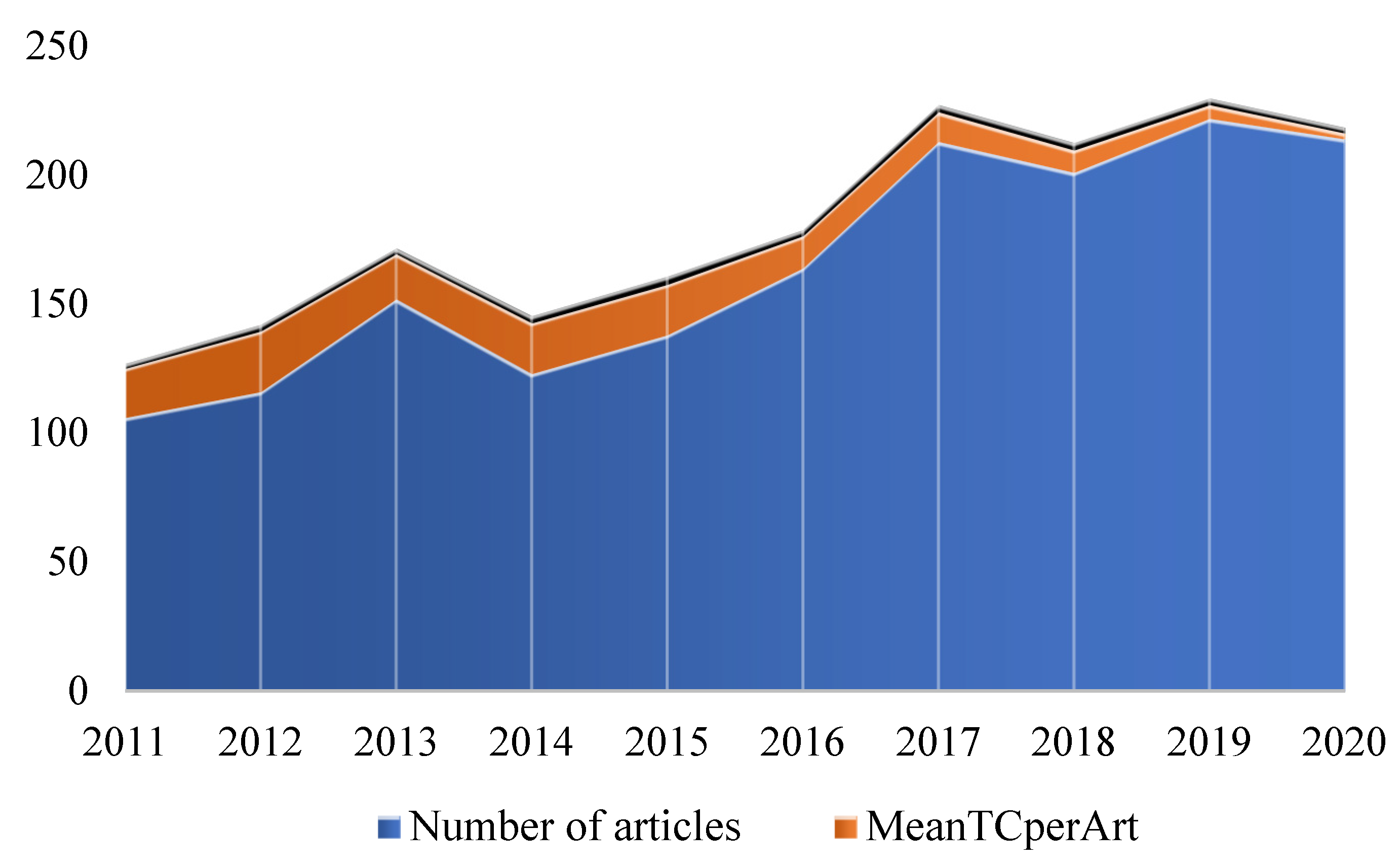
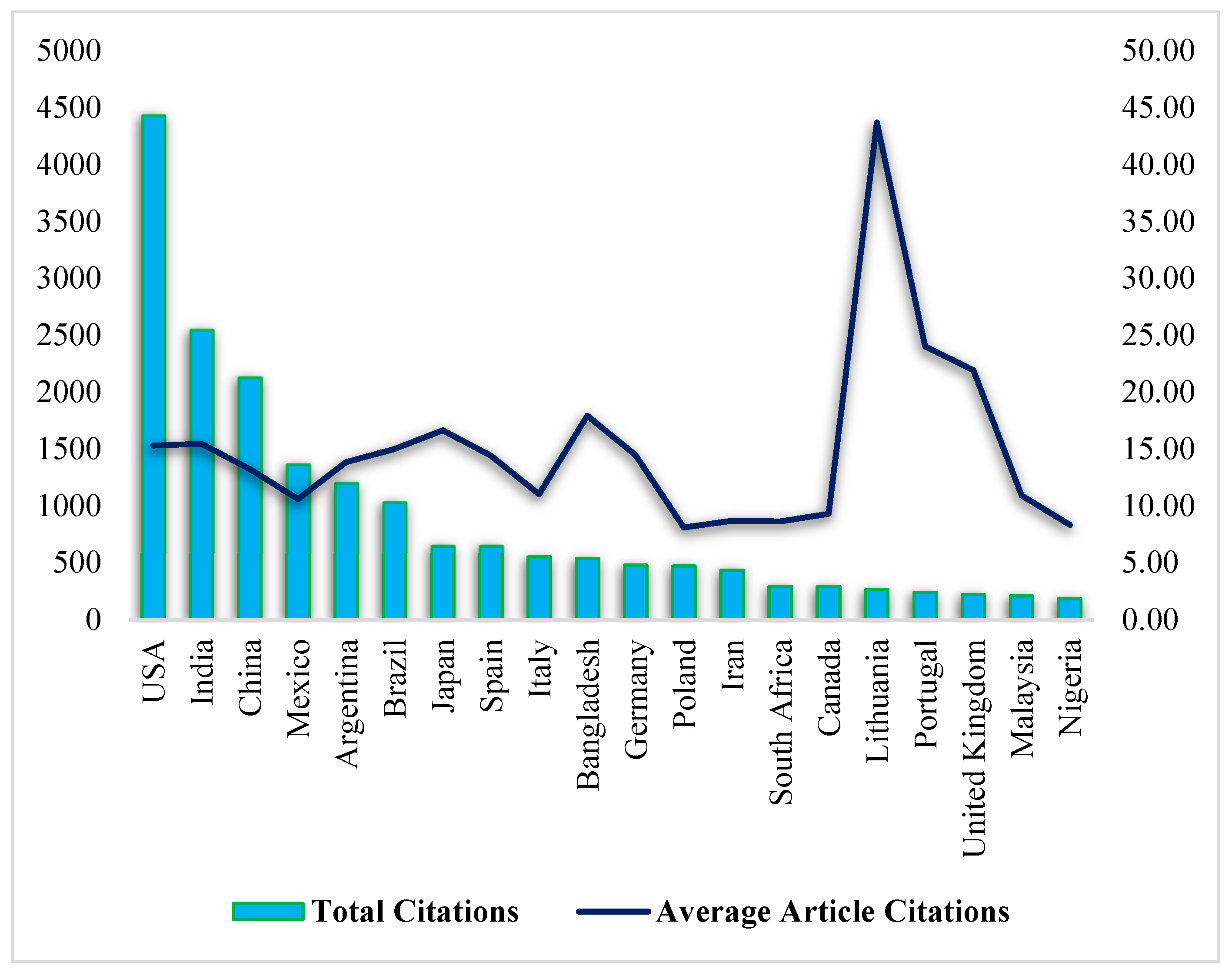
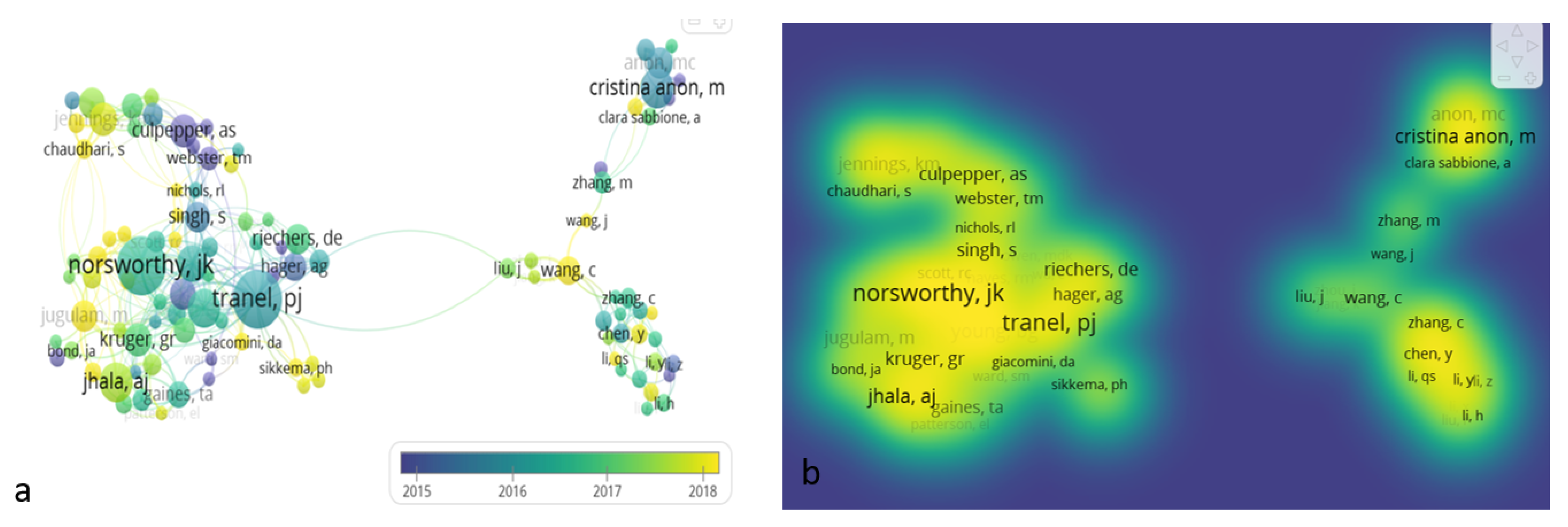
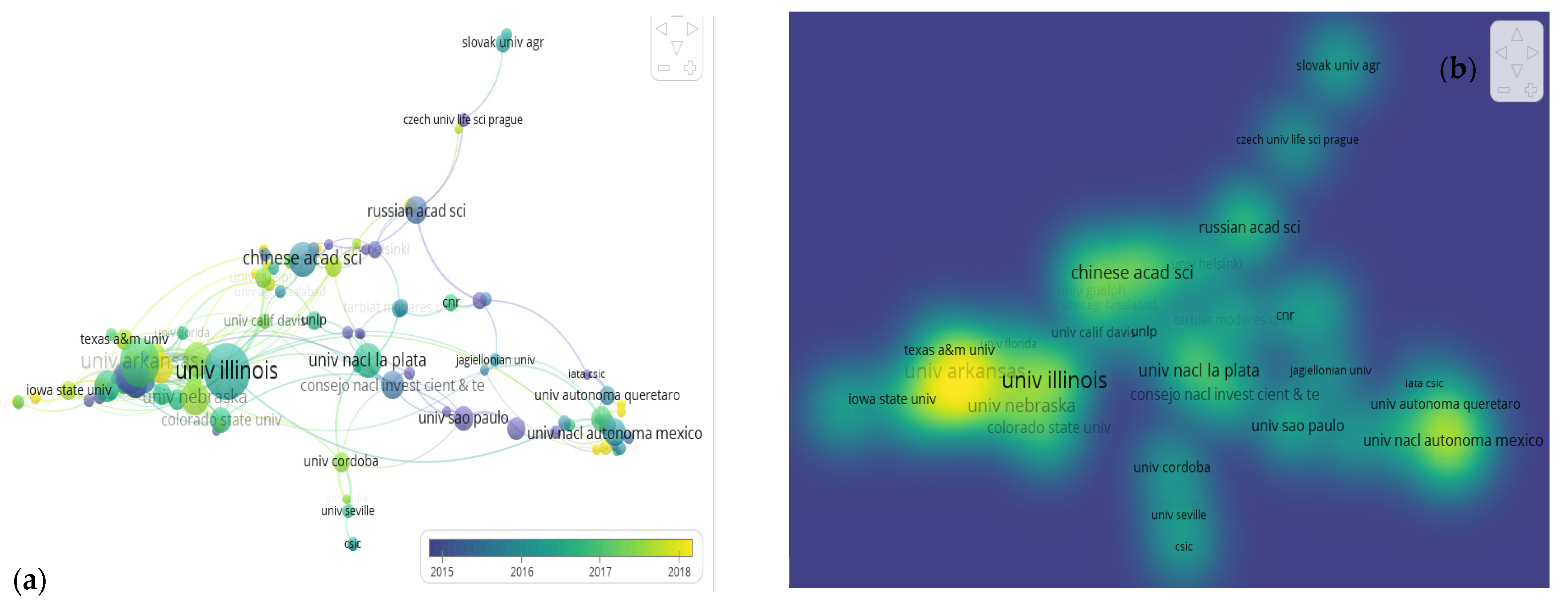
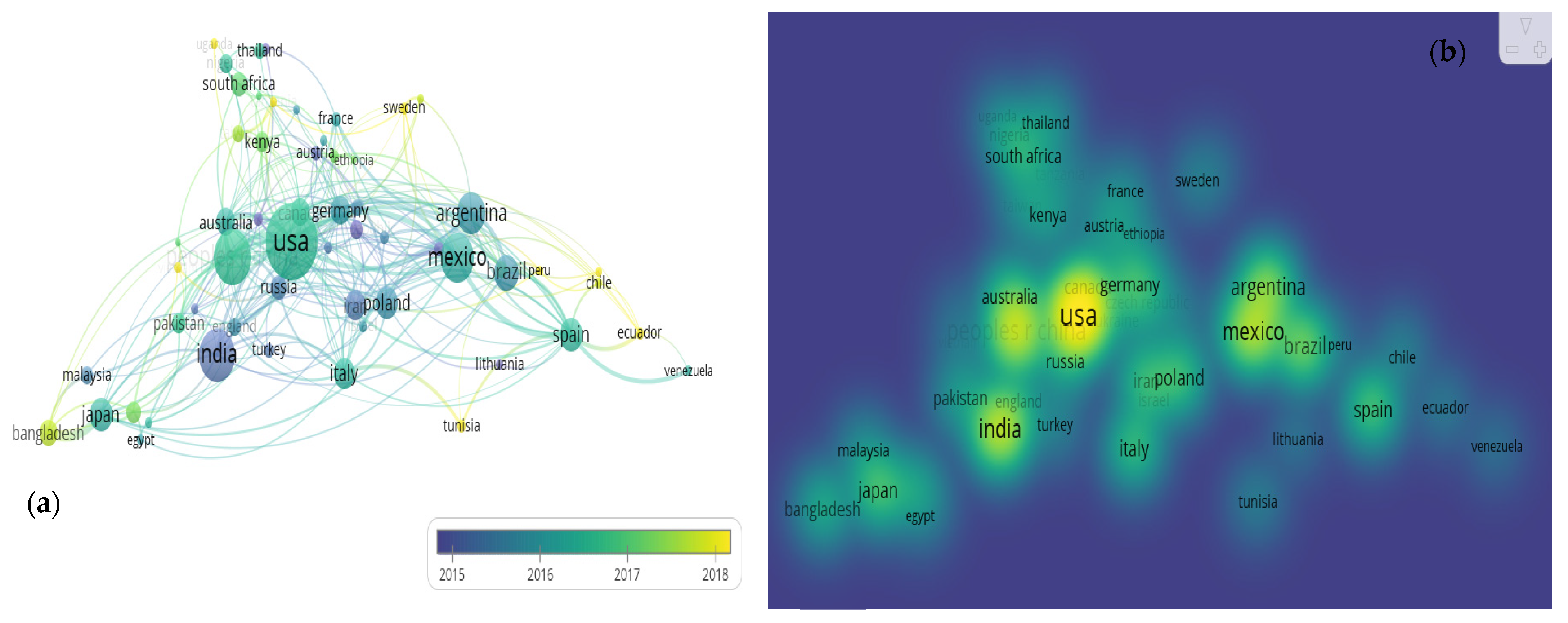
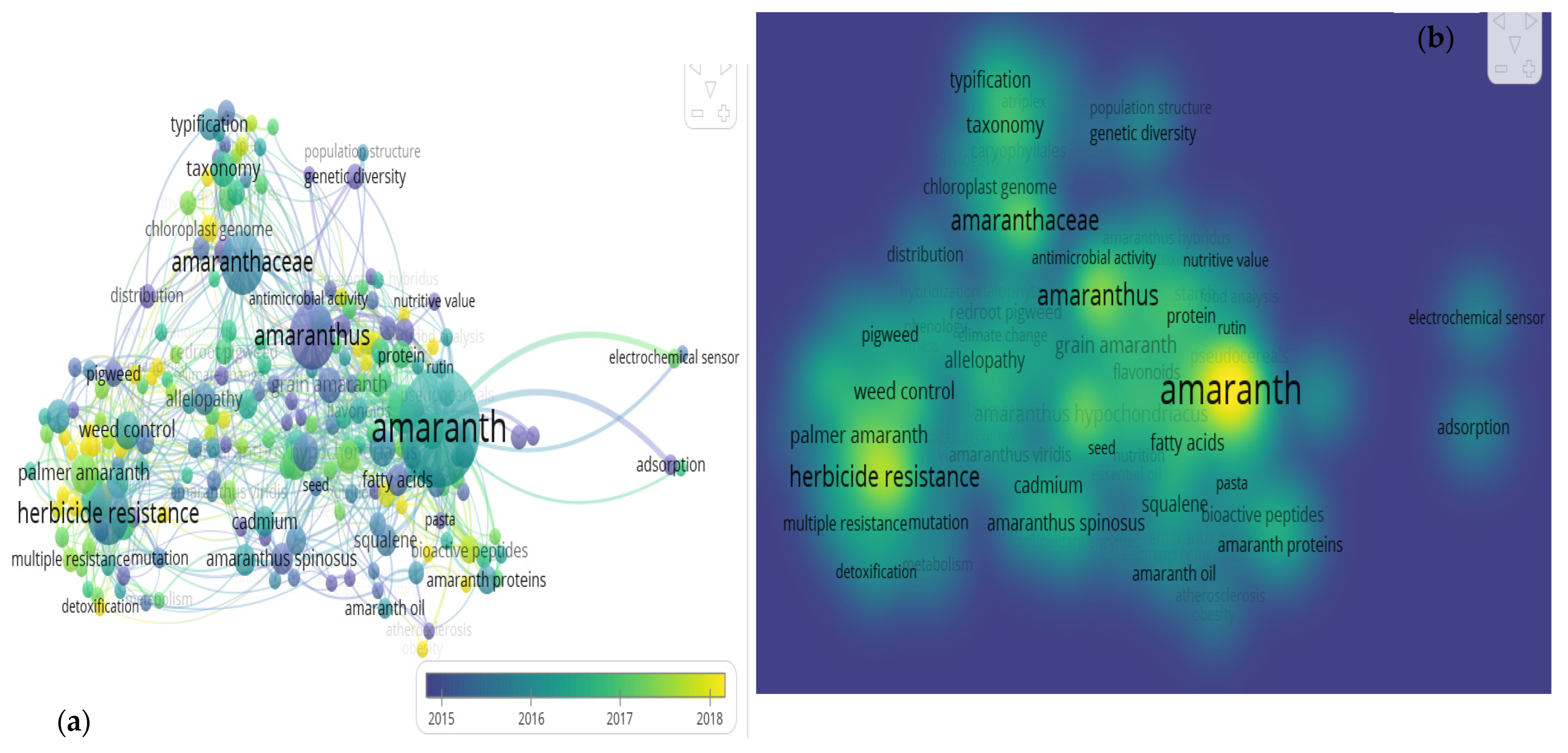
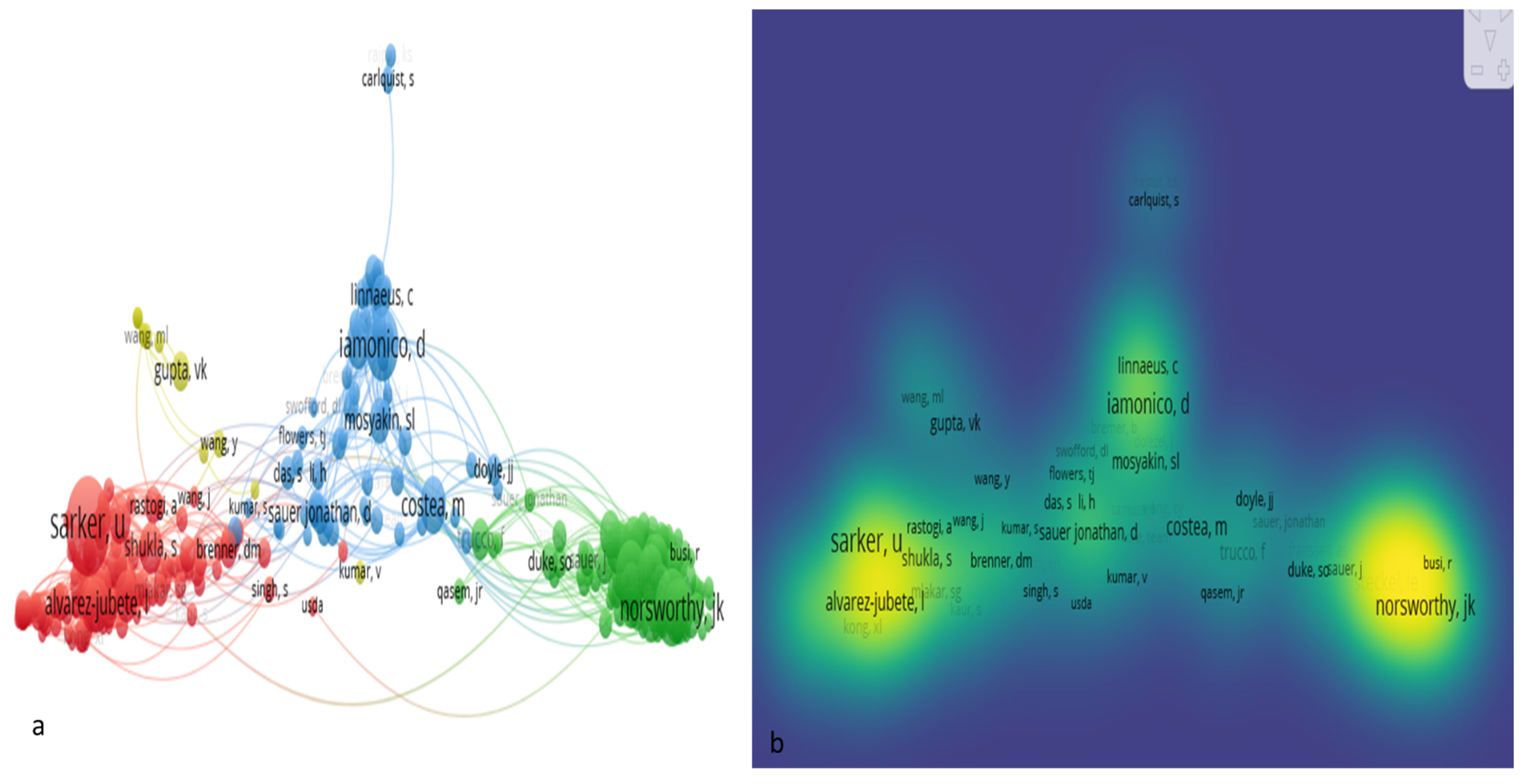
| Description | Results |
|---|---|
| Timespan | 2011:2020 |
| Sources (journals, books, etc.) | 565 |
| Documents | 1649 |
| Average years from publication | 4.82 |
| Average citations per documents | 12.4 |
| Average citations per year per doc | 2.029 |
| References | 47,877 |
| Document types | |
| Article | 1612 |
| Review | 37 |
| Document contents | |
| Keywords plus (ID) | 4096 |
| Author’s keywords (DE) | 4864 |
| Authors | |
| Authors | 5180 |
| Author appearances | 7393 |
| Authors of single-authored documents | 34 |
| Authors of multi-authored documents | 5146 |
| Author collaborations | |
| Single-authored documents | 53 |
| Documents per author | 0.318 |
| Authors per document | 3.14 |
| Co-authors per documents | 4.48 |
| Collaboration index | 3.22 |
| Author | Articles | h-Index | g-Index | m-Index | TC | PY-Start |
|---|---|---|---|---|---|---|
| Norsworthy, J.K. | 34 | 13 | 23 | 1.18 | 601 | 2011 |
| Tranel, P.J. | 29 | 15 | 25 | 1.36 | 647 | 2011 |
| Oba, S. | 28 | 21 | 28 | 2.33 | 810 | 2013 |
| Sarker, U. | 28 | 20 | 28 | 2.86 | 795 | 2015 |
| Iamonico, D. | 25 | 10 | 14 | 0.91 | 226 | 2011 |
| Jhala, A.J. | 18 | 9 | 16 | 1.13 | 272 | 2014 |
| Anon, M.C. | 13 | 9 | 13 | 0.90 | 191 | 2012 |
| Cristina Anon, M. | 13 | 10 | 13 | 0.91 | 378 | 2011 |
| Kruger, G.R. | 13 | 8 | 13 | 1.00 | 216 | 2014 |
| Park, Y.J. | 13 | 5 | 7 | 0.46 | 64 | 2011 |
| Singh, S. | 13 | 7 | 12 | 0.64 | 225 | 2011 |
| Steckel, L.E. | 13 | 8 | 13 | 0.89 | 318 | 2013 |
| Young, B.G. | 13 | 7 | 13 | 0.78 | 179 | 2013 |
| Culpepper, A.S. | 12 | 9 | 12 | 0.90 | 258 | 2012 |
| De | 12 | 5 | 8 | 0.46 | 69 | 2011 |
| Gaines, T.A. | 12 | 9 | 12 | 0.82 | 366 | 2011 |
| Jennings, K.M. | 12 | 4 | 7 | 0.44 | 54 | 2013 |
| Wang, C. | 12 | 7 | 10 | 1.17 | 107 | 2016 |
| Bradley, K.W. | 11 | 8 | 11 | 0.73 | 216 | 2011 |
| Jugulam, M. | 11 | 6 | 11 | 1.20 | 183 | 2017 |
| Affiliations | Country | Articles |
|---|---|---|
| University of Arkansas | USA | 94 |
| University of Illinois | USA | 93 |
| University of Nebraska | USA | 67 |
| Bangabandhu Sheikh Mujibur Rahman Agric University | Bangladesh | 64 |
| Universidad Nacional de La Plata | Argentina | 59 |
| Kansas State University | USA | 55 |
| North Carolina State University | USA | 49 |
| Instituto Politecnico Nacional | Mexico | 35 |
| University of Sao Paulo | Mexico | 34 |
| Mississippi State University | USA | 32 |
| Purdue University | USA | 32 |
| Islamic Azad University | United Arab Emirates | 30 |
| University of Georgia | USA | 29 |
| Institute of Botany | China | 27 |
| University of Western Australia | Australia | 26 |
| Colorado State University | USA | 25 |
| Jiangsu University | China | 25 |
| Source | NP | TC | h-Index | g-Index | m-Index | PY-Start |
|---|---|---|---|---|---|---|
| Weed Technology | 97 | 1196 | 19 | 29 | 1.73 | 2011 |
| Weed Science | 83 | 1441 | 24 | 34 | 2.18 | 2011 |
| LWT-Food Science and Technology | 35 | 947 | 18 | 30 | 1.64 | 2011 |
| PLOS One | 26 | 445 | 13 | 20 | 1.30 | 2012 |
| Scientific Reports | 25 | 405 | 12 | 19 | 2.00 | 2016 |
| Food Chemistry | 23 | 935 | 17 | 23 | 1.55 | 2011 |
| Phytotaxa | 22 | 123 | 6 | 10 | 0.60 | 2012 |
| Frontiers In Plant Science | 19 | 205 | 10 | 13 | 1.43 | 2015 |
| Journal of Agricultural and Food Chemistry | 19 | 498 | 13 | 19 | 1.18 | 2011 |
| Pest Management Science | 19 | 433 | 11 | 19 | 1.00 | 2011 |
| Journal of Cereal Science | 17 | 170 | 8 | 12 | 0.73 | 2011 |
| Journal of Food Science and Technology-Mysore | 17 | 145 | 8 | 11 | 0.80 | 2012 |
| Plant Foods for Human Nutrition | 17 | 263 | 9 | 16 | 0.82 | 2011 |
| Mitochondrial DNA Part B-Resources | 14 | 36 | 4 | 5 | 1.00 | 2018 |
| Environmental Science and Pollution Research | 13 | 102 | 7 | 9 | 0.78 | 2013 |
| International Journal of Food Science and Technology | 12 | 246 | 7 | 12 | 0.70 | 2012 |
| Taxon | 12 | 145 | 7 | 12 | 0.70 | 2012 |
| Food Research International | 11 | 189 | 8 | 11 | 0.89 | 2013 |
| Journal of Functional Foods | 11 | 142 | 6 | 11 | 0.67 | 2013 |
| Journal of the Science of Food and Agriculture | 11 | 142 | 8 | 11 | 0.80 | 2012 |
Publisher’s Note: MDPI stays neutral with regard to jurisdictional claims in published maps and institutional affiliations. |
© 2022 by the authors. Licensee MDPI, Basel, Switzerland. This article is an open access article distributed under the terms and conditions of the Creative Commons Attribution (CC BY) license (https://creativecommons.org/licenses/by/4.0/).
Share and Cite
Jimoh, M.O.; Okaiyeto, K.; Oguntibeju, O.O.; Laubscher, C.P. A Systematic Review on Amaranthus-Related Research. Horticulturae 2022, 8, 239. https://doi.org/10.3390/horticulturae8030239
Jimoh MO, Okaiyeto K, Oguntibeju OO, Laubscher CP. A Systematic Review on Amaranthus-Related Research. Horticulturae. 2022; 8(3):239. https://doi.org/10.3390/horticulturae8030239
Chicago/Turabian StyleJimoh, Muhali Olaide, Kunle Okaiyeto, Oluwafemi Omoniyi Oguntibeju, and Charles Petrus Laubscher. 2022. "A Systematic Review on Amaranthus-Related Research" Horticulturae 8, no. 3: 239. https://doi.org/10.3390/horticulturae8030239
APA StyleJimoh, M. O., Okaiyeto, K., Oguntibeju, O. O., & Laubscher, C. P. (2022). A Systematic Review on Amaranthus-Related Research. Horticulturae, 8(3), 239. https://doi.org/10.3390/horticulturae8030239







